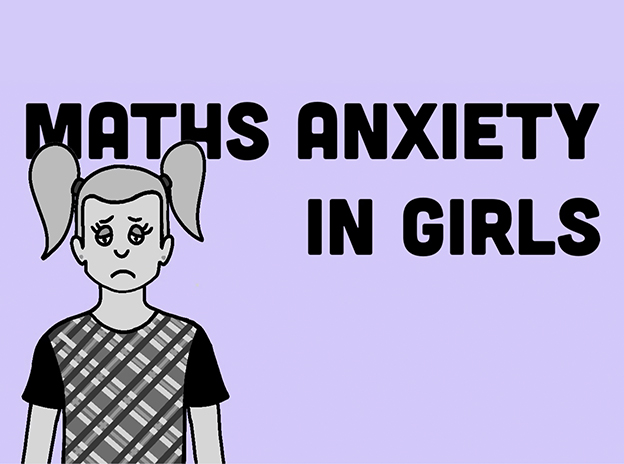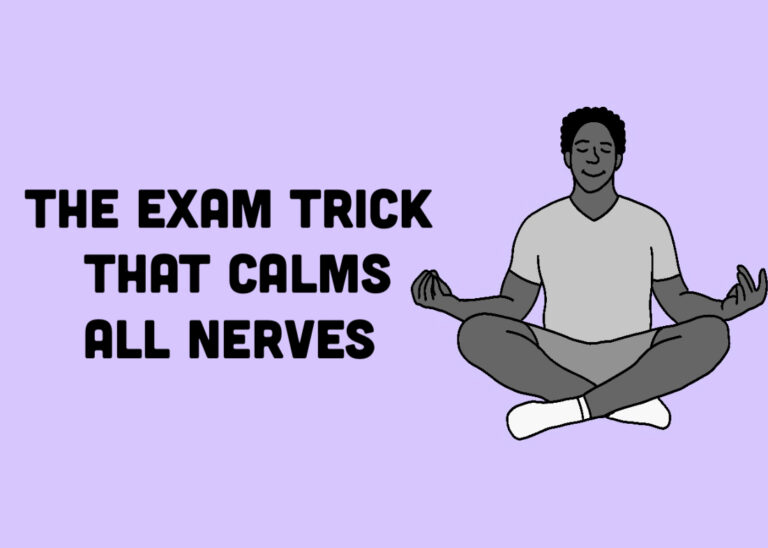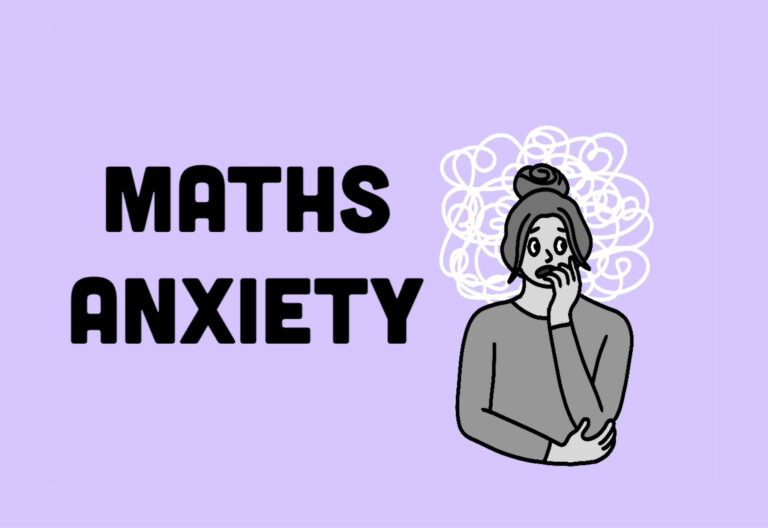WhatsApp:
+353 87 202 0389
Girls Are 2.5x Less Likely to Score Top Maths Grades
Let’s start with the facts. In Ireland, girls’ performance in Maths has declined over the past 20 years by almost 30%. Since 2002, the gender gap has widened, and girls are underperforming compared to boys, especially at the highest levels. And yet more girls sit higher level Junior Cycle Maths. Strange.
What’s happening here? Is it just an ‘Irish thing’ or is it a global phenomenon?
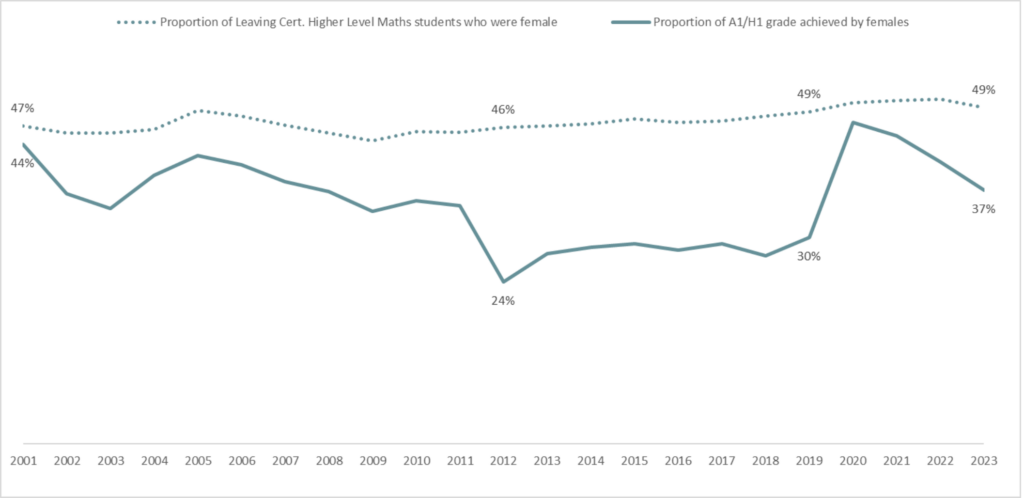
An Overview
The Numbers Don’t Lie
I’m teaching Maths for 13 years. I had no idea that this was a problem. Until I started to dig. The statistics are astonishing:
— Only 33% of Girls receive the top Leaving Cert grades.
— Twice as many boys apply for STEM courses at University than girls.
— 3 times as many men work in STEM in Ireland than women.
Despite this, it’s roughly a 50:50 split at Higher Level Leaving Cert Maths between boys and girls.
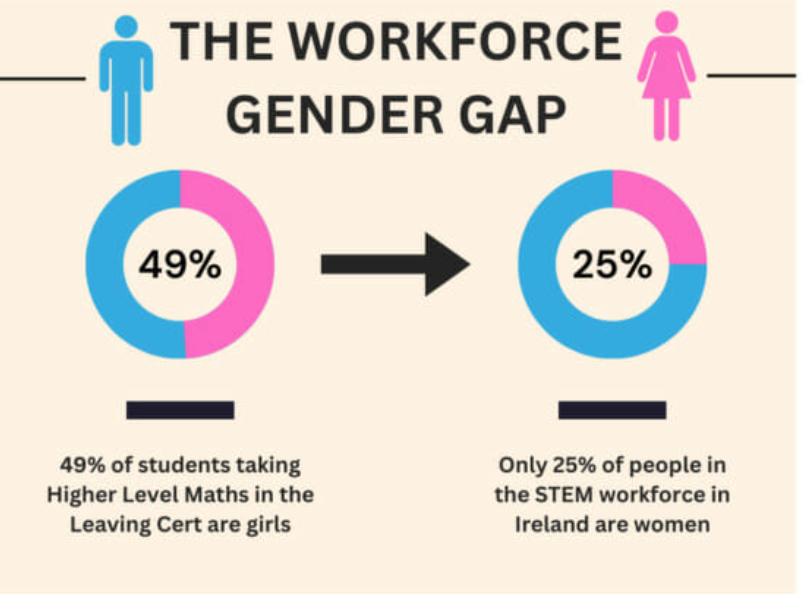
Leaving Cert vs A-Level
The A-Level Maths exam is equivalent to Leaving Cert Higher Level Maths in Ireland.
Participation
In England, 39% of A-Level Maths students are female, while in Ireland, nearly 48% of students taking Higher Level Leaving Cert Maths are girls. However, despite this higher participation in Ireland, only 27% of STEM college places are filled by women, a pattern also seen in the UK. This under-representation of women in STEM fields is a common challenge in both countries.
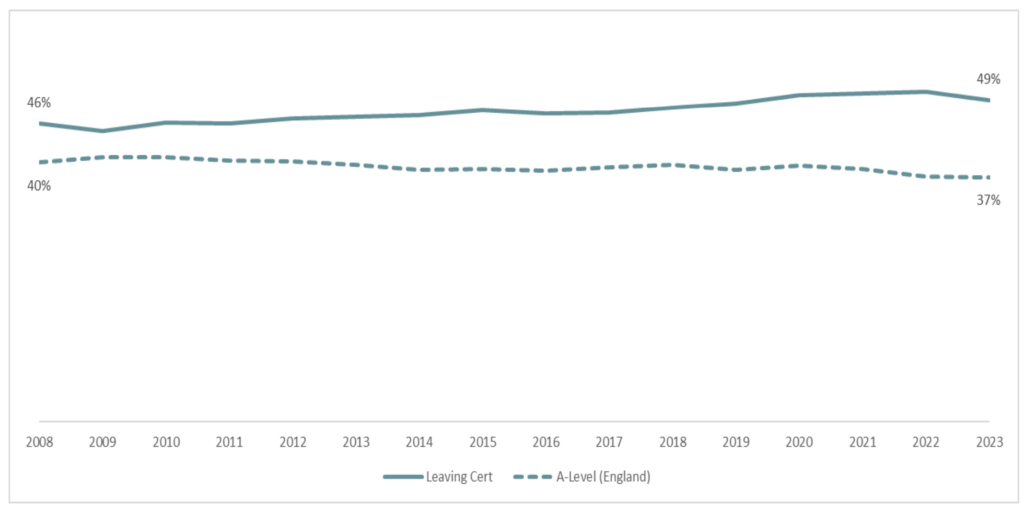
Exam Performance
But here’s the difference: girls in Ireland massively underperform at the top grades. Only 30% of H1s (the highest grade) go to girls, while in England, 33% of A* grades are awarded to girls. That’s a much closer alignment to the percentage of girls sitting the exam. In other words, when girls take Higher Level Maths in Ireland, they are more likely to underperform compared to their English counterparts at A-Level.
Girls Struggle In Exams
The predicted grades during Covid provided some very interesting results. Teachers, when marking the 2020 Leaving Cert, were effectively asked to predict how their students would perform.
The picture that emerged was one in which teachers presented highly positive assessments of the girls they taught, “arguably reflecting both their own perceptions of their competence as teachers and the girls’ willingness to co-operate with them”.
Low and behold, as soon as we return to actual exams, the performance of girls drops by almost 60%.
That’s a tell-tale sign. In the actual Maths exam, girls struggle.
Has Project Maths Helped?
In short, not really.
When Project Maths was rolled out in 2012, the goal was to make Maths more relevant. Less memorizing formulas, more applying Maths to real-life problems. Great idea in theory.
But in practice, it’s been a mixed bag. Project Maths introduced “unseen” application questions that test how well students can solve problems in unfamiliar contexts. The problem? These questions rely heavily on spatial reasoning, a skill where boys generally outperform girls.
Research (Roche et al., 2019) shows that there’s a gender gap in spatial ability—and it only gets worse as students go through secondary school. By focusing so much on these types of questions, Project Maths is inadvertently making it harder for girls to succeed at the highest levels.
Plus, girls are less likely to take subjects that boost spatial reasoning, like Applied Maths and Physics. And some schools—particularly all-girls’ schools—don’t even offer these subjects. That’s a huge disadvantage right there.
Project Maths has doubled the participation rates at Higher Level Maths from 15% in 2011, to over 33% in 2024. The 25 extra bonus points has been the main driver of the uptake in Higher Level. Maths.
The Causes
1. The Maths Has Changed
Project Maths Has Not Worked
Maths exams are now more complex.
The new Higher Level Leaving Cert exam introduced in 2012 became much less predictable. Instead of stand-alone questions, students now face interconnected, multi-layered problems. The focus has shifted heavily toward problem-solving and higher-order thinking skills, which the Chief Examiner acknowledged are:
‘Skills that students find difficult to master and teachers may find difficult to instil’
Maths is less rote now and more about problem-solving. And in my opinion, girls are disadvantaged here for a few reasons.
Girls Struggle With Spatial Reasoning
Spatial ability involves understanding and using the properties of space to structure problems and find solutions. Research shows a strong, well-established link between spatial reasoning and mathematical success, making it a key predictor of performance in Maths.
Spatial ability and problem-solving ability are related. Spatial reasoning can reduce working
memory load and increasing success in solving mathematical ‘word problems’. In short, when solving problems, girls tend to get more overwhelmed.
2. We ‘Underteach’ Maths
Too Few Hours
Ireland is the 3rd lowest in the OECD when it comes to time spent on teaching Maths.
According to TIMSS data, Ireland allocates 193 minutes a week to Maths class in Second Year. The OECD average? 201 minutes. Doesn’t sound like a huge gap, but over a year, it adds up. Irish students get 109 hours of Maths annually, while their OECD counterparts average 131 hours. In countries like Canada, they dedicate a whopping 18% of total class time to Maths, compared to Ireland’s meagre 11.3%.
It’s no wonder teachers feel rushed, trying to get the curriculum finished. Students complain that they don’t have time to focus or revisit tough concepts. With less time on the clock, it’s a scramble to just get through the curriculum, let alone dig deeper into understanding.
1st Year Is Wasted
In 1st year, Irish students are mixed. Often times, the class will go too slow for many students. Progress is slowed. When the classes are streamed in 2nd year, you can see a huge issue appearing with the introduction of Algebra. Many students are coming into the Higher Level stream with a poor grasp of the basics. It would be far better to stream from the start of first year and be in class of equal ability students. The teacher could teach more accurately to the speed of the class.
3. The Stereotype Problem
Stereotypes Are Hard Wired
This article in the Irish Times spoke volumes to me. From as young as 9 years old, the steroetype of girls being poor at Maths begins to show among students.
The Growing up in Ireland study in 2020, had a fascinating quote from the researcher
These stereotypes are so strong that they override the evidence of the girls’ and boys’ own achievements in nationally validated mathematics assessments.
The statistics show up everywhere. A US survey showed 91% of women believe men are better investors, despite women outperforming men by 0.4% every year. In Ireland, the standards improved for girls throughout the 19th and 20th centuries. There was still a barrier as late as 1985, though, with the primary school curriculum allowing for “separate arrangements in movement training” for boys and girls. This allowed boys to learn skills and techniques, while girls learned style and grace.
Trinity College Dublin didn’t allow women to attend until 1904 despite opening in 1592. Cambridge did not award degrees to women until 1948 despite opening in 1209. Even more recently, Ecole Polytechnique, one of France’s most prestigious institutes, only started admitting women in 1972. Even after opening universities to women, there were still few women earning Maths degrees. In the 1960s and 1970s, there were only around 30 women in Ireland with Bachelor’s Degrees in Maths.
For much of the 20th century women weren’t allowed to work in Ireland and be married. In 1937, Margaret MacDonnell, who had a Masters in Maths, was fired from her job as a professor after her marriage. Even as recently as 1977, women working in banks or for the civil service were legally forbidden from keeping their jobs if they got married. No wonder the number of women with Bachelor’s Degrees in Maths was so low. Why would someone go to university if they wouldn’t be allowed to get a job afterwards?
Playing Themselves Down
I believe girls downplay their abilities and achievements more than boys. This is known as a lower “self-concept”. The main reason girls have a lower self-concept for maths is due to how their parents, teachers, peers and the media speak about girls and maths. We all need to change the conversation and to improve our relationship with maths.
Sometimes, I feel that boys are more brazen than girls. That boys will get stuck in and try, fail, learn a lot more than girls.
When I talk to parents, something else strikes me. I often hear mothers say they were never good at Maths, that it’s the dad who helps the kids with Maths.
Brazen Boys, Hesitant Girls
This is based on my own opinions. Learning Maths effectively is all about try, fail, learn, try again.
Global research has shown that boys are more than 50% more confident than about their own Maths abilities.
I always say that Maths is 50% magic, 50% method.
Yes, you need to put in the reps of study and test prep. But you also need that belief. Because in any given Maths exam, you will have ‘fail’ 50, 60 to 70 times. These are mini failures. It’s all part of that ‘try, fail, learn, try again’ approach to Maths. You can get a 90% mark in the Leaving Cert HL exam, without getting a full question right. It’s about the steps leading up to the question.
But you don’t have that level of failures, and subsequent frustration in a subjective exam like English or History, for example. It’s a distinct Mathematical problem.
But, that’s hard to take. If you’re lacking confidence initially, failing 50 or 60 times in an exam will impact your results. The ‘magic’ piece, the mindset of being open to trying and failing, it’s important.
US STUDY
The Solution
More Geometry, Please
Geometry is the study of shapes. It’s a core part of spatial reasoning.
To fix the inherent gap, research has shown that more time spent teaching on geometry is effective. Our curriculum is too broad, too unspecialised. We need to focus more on Geometry.
Not just geometry, but in reading Mathematical terms. It’s noted that there has been a significant increase in the volume of words on maths papers since the introduction of Project maths. 1 in 10 students have dyslexia, 1 in 20 students have ADHD — you’d be surprised at how a change in vocabulary would throw a student off.
Role Models
Again, I refer to my rule — Maths is 50% Magic, 50% Method.
Let’s focus on the magic part. On the subliminal effect of having people to look up to. We need more female role models in STEM.
Today’s biggest tech companies were all founded by men. Imagine if Steve Jobs, was Stephanie Jobs? Or if Melinda Gates had made Microsoft, and not Bill. It would have a knock on impact. Students are impressionable.
You have to see it to believe it.
So, please, more female role models. More females leading tech companies. More females heading to space. More females on our airwaves talking shaping the future of tech in Ireland.
Change Girl Math to Girl Genius
So, for the last few years on social media, there has been a trend around #girlmath
It’s a running joke around the roundabout ways girls compute different things in their heads. A bit like the #girlboss trend.
It’s light-hearted. But it’s also inherently sexist and gender discriminating.
Not to suddenly become a woke 30-year-old here, but I’d love to change that narrative. I’d love to make it a competition — that girls are brighter than boys.
Because students are impressionable. Narrative matters. Let’s flip the script here.
Finally, Grinds do help
We have over 890 students with us each week. Of that number, over 74% of our students are girls. Parents and students just recognise that an extra hour or two a week of practice makes a difference to that confidence. If you need help for the Junior Cycle or the Leaving Cert please reach out to me and the team here.
Further Reading
Here are a few more tips for parents on growing your Maths confidence, read this blog.
Conclusion
Listen, the first step in any of this is awareness.
The stats are shocking. Parents, teachers and students themselves are not aware of this huge divide.
What’s also very evident from my research is the fact that Project Maths has not delivered. The idea is right, but the execution is wrong. The exams have changed in terms of complexity, but our teaching methods are mostly teh exact same. Why are we teaching so many topics? We are sending in students, and girls in particular, unprepared for the demands of problem solving, complex questions.
We can, and must, do more.
TJ
Breakthrough Maths CEO
Need help in Maths? Contact my team here to book grinds or for some notes.

FAQ’s
‘Girls in STEM’ refers to young female students exploring Science, Technology, Engineering, and Mathematics (STEM), aligning with the broader goal of increasing female representation in these fields, similar to the ‘Women in STEM’ initiative. This term is used to encourage and support girls in pursuing interests and education in STEM fields from an early age, aiming to challenge traditional gender roles and promote diversity and inclusivity in these crucial and evolving sectors.
Maths is central to STEM as it forms the foundational basis for understanding and advancing in other STEM disciplines. For girls in STEM, gaining proficiency in mathematics fosters critical skills like problem-solving and logical reasoning. Moreover, engaging with mathematics helps challenge and break down gender stereotypes often associated with STEM fields. Encouraging girls to delve into mathematics is a step towards promoting a diverse, innovative, and equitable future workforce within STEM, echoing the overarching goals of the broader ‘Women in STEM’ narrative.
STEM is an acronym representing four interconnected fields:
- Science: The exploration of the natural world, encompassing disciplines such as biology, chemistry, physics, and earth science.
- Technology: The application of knowledge to create tools, systems, and processes that extend human capabilities and solve real-world problems.
- Engineering: The discipline of designing, building, and maintaining structures, machines, and systems through the application of scientific principles.
- Mathematics: The abstract study of numbers, quantities, shapes, and patterns, which forms the bedrock for logic and problem-solving in various contexts.
STEM embodies a collection of knowledge and skills crucial for navigating and solving contemporary challenges. It is a driving force behind innovation, economic development, and human progress. The interdisciplinary nature of STEM education equips individuals with a versatile skill set, preparing them for a broad spectrum of careers in sectors like healthcare, information technology, aerospace, automotive, and environmental conservation, among others. Moreover, STEM education cultivates critical thinking, problem-solving abilities, and the practical application of knowledge, rendering valuable competencies for success in numerous professional realms.


